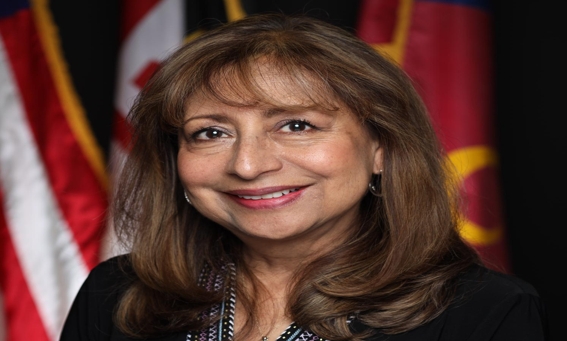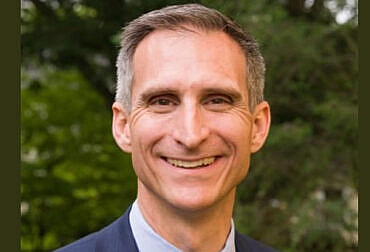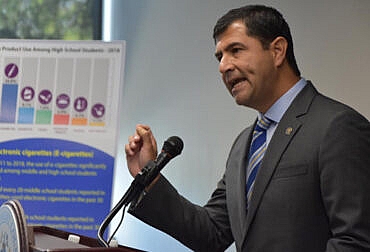Nagender Madavaram discussed with Assistant Chief Administrative Officer, Ms. Sonia Mora about her role during COVID. Prior to joining the current office, Sonia served as the Director of Por Nuestra Salud y Bienestar, an initiative aimed at providing an integrated response to address the impact of the COVID pandemic in the Latino community. She worked 30 years at the Department of Health and Human Services. She received ‘Latinx Heroes: Leading, Healing, and Providing Hope During the Pandemic’ award from Montgomery County Council in 2020. Sonia holds a Bachelor of Science from Marymount University and a Master of Public Health from Walden University. This is the first of a 2-part transcript of the interview which covers topics of vaccination in Latino community, food security, improvement of public health services and children services.
Vaccination in Latino Community:
Nagender Madavaram: Montgomery County attracted attention of the nation by vaccinating more percent of minorities. What was your role in successfully vaccinating Latino community in the County?
Sonia Mora: I worked last 30 years for the Department of Health and Human Services. I did a lot of work in the previous epidemic, which was HIV. One of the largest ones you know. I was actually a public health advisor doing a lot of health education and outreach. I did set up programs for the community as well and doing testing and counseling for detention centers and churches. I started my career with the Department of Health and Human Services. Around the year 2000, I started the Latino Health Initiative as part of the Department of Health and Human Services. We have National Health Initiative. The Latino Health Initiative was really a big focus to begin to identify the particular health needs that Latinos have in Montgomery County. We need to think about what are the assets that these communities bring so that when we develop programs, we can take advantage of those assets. So, with the Latino Health Initiative, one of the key principles was to begin on partnerships, the Latino Health Initiative has a steering committee that is composed of about 20 members those have expertise in that history at the national, state, and local levels. So, this category of people has been together, you know, it has years of experience in policies. Out of those 20 people, there were several agencies that have been working with them for a very long time. Several organizations that have been there for the last 20 years. All these groups have been working together, not on a programmatic level, but maybe policy and advocacy.
So, when the pandemic started it was really crazy because there was a significant impact on the community. So, about 20% of the county’s population is Latino so that the largest minority group in Montgomery County. Out of those individuals, about half of them, about 54% were born outside of the United States. A very interesting fact is that Latinos are a very young population. About 90% of females are under the age of 64 that makes this is a vibrant community. A significant number of people are working and contributing to the county. About 87% of Latinos are multilingual, they speak other than English. Interestingly, about 50% of Latinos say that they speak English very well. Now, in terms of the income, the median income for the Latino household is about $75,000 in comparison to 141,000 for the general population. So, if you think about it, it’s a significant disparity. Several Latino people are living together, different generations working together, so that makes it more significant.
About 50 percent of Latinos are working in different occupational areas that pay very low wage such as service industry, driving cabs, working in restaurants and hotels. So, this is really important aspect of workforce because these were the occupations I asked when the pandemic hit. These were the frontline workers that never stayed home unlike many of us have the privilege. I was one of them, I could stay at home. At the beginning, we didn’t have vaccines and we didn’t even know about it. We really didn’t have PPE. We didn’t have a lot of essential pieces too protect ourselves. So, another significant factor is 30% of the population does not have health insurance. That’s a very high rate. That means 30% of people don’t have access to healthcare, and by not having access to healthcare, it makes really difficult to receive preventive treatment. When we look at health statistics in terms of diabetes, heart disease and other diseases they are vulnerable.
In the month of June 2020, we began to look at the numbers of COVID patients among Latinos. We got alarming evidence that needed to do a specific initiative program to address the needs of this particular population. We couldn’t just go by the regular education that was being done in the planning. It was pretty amazing. We needed to have a special program to target this community in the appropriate way. That’s an important piece because that’s something we always discussed when we’re talking about serving diverse communities in Montgomery County. I mentioned a few minutes ago that we already had a steering committee that had been working together for many years and there were several organizations that were part of that group. So, having that group we didn’t have to start from the scratch to get to know each other. The other part is that we have a commonality and linkage through Spanish that’s the language that unites the community. We have a very vast number of media outlets as well. So, you have the radio and other significant assets to address the pandemic. The Latino Health Initiative was asked to come and develop a work plan to address the covenants of the Latino community here in Montgomery County. Within a couple of days, we developed a model plan and in six weeks we were able to execute the plan.
Remember, we didn’t have vaccine back then so, we used some of the existing programs that the Latino initiative had, and then we created other pieces in terms of community engagement and education. We enhanced the capacity of the information line so that community could call and find information about COVID. They could find information about where the COVID test could be done and where they get different services? It was like an information and navigation line that we adopted. The other piece is treasury of health workers. We call them health promoters. About 25 of them were part of the native initiative and others were part of other agencies who brought them all together under one umbrella, trained them and gave them tools. They explained the community about COVID, prevention, social distancing and wearing the mask. Since very beginning, August 2020, they were out there. I really wanted to give a big applause to them because there were few people out there with vaccinations when there was nothing else. So, we knew that it was important to have people on the ground, but we also knew that we needed to engage people to different venues through communications campaign. We used television. So, we have a locations campaign, social media, radio and television.
We were also providing other services. On the clinical side, we began to provide testing, and vaccination. When people need assistance, a hospital like home we would go to people’s homes to take care of them. There was also a case management component, so it was for people who needed to apply for services that they can’t apply themselves. There were about 30 workers were there helping individuals. We were also providing supports to some of the hubs. In essence, it was a comprehensive program. It was pretty successful. We surpassed the white population in terms of vaccinations. Montgomery County had the highest vaccination rates in minority communities.
Food Security:
Nagender Madavaram: The county has distributed huge amount of food successfully for needy people. What was your role in providing food security to minority communities?
Sonia Mora: The holy job of food security was begun sometime before pandemic. I know that County Executive was really interested in developing hubs. Particular hubs not just for food distribution, but eventually places where people can come and get services. So, it’s a bit of a policy of decentralization of services. So, we worked even before that we received the funding for COVID through the Latino initiative. We were trying to help them in providing not only food but other supplies. Diapers, care kits and all those kinds of things. We were able to allocate funding of $1.3 million to support all the hubs, so that we could hire bilingual staff. It was difficult to identify bilingual staff. Recruitment of staff was part of the work that we were doing. We also provided support to community-based agencies and Catholic charities. Now for the new fiscal year 2022, funds have been put specifically under another person that handles the hubs but we continue to work with them as much as we can. Vaccination or education or testing whatever help they need from us that continues up to this day.
Improvement of Public Health Services:
Nagender Madavaram:You have good experience in public health. Do you have any suggestions to make for improvement of health services?
Sonia Mora: No department is perfect, correct? Change is needed as circumstances change. Communities change when new people arrive. We need to step up with the tide. I know that as the general rule, government moves slow in some ways, right? Now that the pandemic is in a hiatus, we’re hoping that we’re not going to be ending up as we were a few months ago. Frankly, the entire county government is seeking a look at how we responded in the pandemic. What we did well? Where can we improve? Obviously for the Department of Health and Human Services, particularly in public health services, is looking in terms of the public health aspect. I think we did really well because we work in partnership with community agencies. Public and private partnership was established very strongly during COVID. It was happening before, but not to the extent in order to enhance our services more effectively and efficiently. I can see how these partnerships are going to continue to grow. Our county government, as you probably know, has established an office of grants management. So, this office is beginning to bring in personnel.
The whole idea is that if we have the ability to provide grants to our community partners instead of just contracts, we might be able to move resources faster. We may be able to do more creative. The whole issue of having contracts in place becomes a little more difficult because it’s a complex way of procurement. I think working in partnerships is better because county government cannot do everything. So, we’re doing a couple of things that actually help, one is obviously having virtual access to services and applications. People apply online, they don’t have to go all the way to the Department of Health and Human Services, that’s a really positive step. There is a segment of the community as you know that is going to need help to apply for services. We have hubs to support them.
The Health Wellness Centers in the schools, that’s going to be another effort within the school infrastructure. Hopefully, we will be able to serve families as a whole right within this system. I think those are things I see to be really positive within this year of Health and Human Services. I see already, things are changing and happening. That’s going to be a good way to facilitate access and quality of service.
Children Services:
Nagender Madavaram: Children services are in your portfolio. What services the county is providing to the children?
Sonia Mora: I have some kind of oversetting connections with different departments. For example, the Recreation Department has significant number of after school programs for children and youth. They’re working with positive youth development initiatives. So, part of my role is understanding what they’re doing and helping them to move certain pieces together. Now, they are getting ready for community center that was occupied by our homeless population. So, is there anything that I can do to help them to expedite work with the budget? Part of my role was to help our Office of Management and Budget about the needs of the department. They had a tremendous number of vacancies that they had not been able to fill, and they also needed more staff to be able to accomplish their work. So, that component is part of my role. The same happens with libraries, I am helping them to understand and making connections as we’ve had recently distribution of COVID test kits.
The other entities that have more of a layer somewhere, it’s MCPS. So, MCPS is really interested at this point in doing better engagement with communities of color, Black and Brown communities. They have a work group that is working with some recommendations and ways to enhance the engagement with these communities. I’m also participating in discussions about where do we move in future? So, I am at those meetings participating with the Department of Health and Human Services and making those connections with the MCPS. As you know, we have newcomers. We simply had Afghan refugees, so part of my role is how do we serve better these communities? For example, like one thing that recently was achieved that MCPS is giving waiver to these refugee children who were supposed to be here for a very short time. They were not enrolled in school because they were not going to be here permanently. They were going to be moving to other locations soon, but some of them have been here for several months. Now, MCPS has given a waiver to allow these children to come to school. The Montgomery College has the good number of students from minority community. The establishment of an East County Educational Center for Montgomery College will be turned into a campus. The campus will serve students in East County. So, I am involved with some of these pieces.











